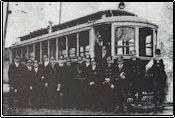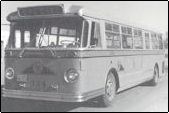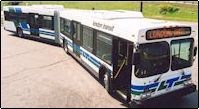Public transit services commenced in London on May 24, 1875 when excited Londoners, celebrating the holiday proclaimed for Queen Victoria’s birthday, clambered aboard horse drawn cars for the ride along Dundas Street between Ridout and Adelaide. Later that year, service commenced on Richmond Street between Dundas and Oxford streets.


Public transit began as a convenient alternative to walking and has developed into a vital service supporting sustainability for progressive, modern cities.

130 Years – Past and Present
1873
Legislature of Ontario authorizes the London Street Railway Company (L.S.R.) to provide passenger service.
1875
City Council grants the L.S.R. the rights to “build, maintain and operate a street railway powered by animal power” for 50 years. The L.S.R. purchases land on Dundas Street (at Lyle Street) for $700. First cars arrive from Ontario Car Company costing $725 each. Mr. Hathaway of Cleveland is contracted to build three miles of track at $5,000 (US) per track mile.
1884
Stable has 146 horses compared to 6 in 1875 and service extends into the suburbs.
1895
Electric-powered cars are introduced. 18 miles of additional tracks and 4 miles of tracks to the entrance of Waterworks (Springbank) Park are built at a cost of $339,500. The horses are sold at a public auction. The horse cars are also sold; some becoming camping cottages in Port Stanley.
1897
Popularity of Springbank service requires a second set of tracks. The L.S.R. builds a barnlike theatre in the park to increase passenger volume, and, although popular, success ends when theatre burns in August.
1898
Employees form the first union within the L.S.R.; motormen and conductors go on strike suspending service for 12 days.
1899
79 motormen and conductors strike and suspend service. Company hires new employees and restores service. This action provokes riots from June to September; the Militia is called out, the Mayor reads the Riot Act.
1900
Labour unrest remains as the company continues service with non-union employees.
1903
Five double-truck streetcars arrive from the Ottawa Car Company.
1904
Flooding Thames River washes out part of the tracks and electric lines to Springbank.
1906
Service extended to South London. Conductors and motormen receive pay increases to 18 cents an hour.
1907
Additional cars and routes increase electricity demand beyond the capacity of the steam generating plant on Horton Street. Battery storage is introduced.
1914
L.S.R. purchases electricity from Ontario Hydro and closes its generating plant. Sunday service commences on February 22 after several years of discussion and objection. War increases passenger volume, particularly from soldiers in training at Wolseley Barracks.
1917
Employees form a new union.
1920
Ontario Railway and Municipal Board takes over operation of L.S.R. when a strike stops service. After months of negotiations, employees receive raises of four to eight cents an hour.
1922
Five one-man streetcars commence service. The drivers (motormen) handle sale and collection of tickets abolishing the need for conductors and thereby saving money.
1923
The first scheduled bus operates on Quebec Street as a private venture. The L.S.R. provides transfer privileges and continues to add streetcars.
1924
Other buses provide service to areas in North and South London, linking with L.S.R. service.
1926
L.S.R. purchases 6 buses from the Yellow Cab Company in Illinois for $7,700 each, which commence service in north and south residential areas.
1936
The trolley to Springbank Park ceases to operate because of losses caused by bus competition.
1940
Buses take over Oxford and Richmond routes in November and streetcars continue only on Dundas Street until a blizzard damages the line on November 27 and the last streetcar is towed to the barns.
1941 – 45
Bus fleet grows annually and World War II boosts passenger volume to record. Heavy bus usage requires constant maintenance, hampered by war restrictions on materials and spare parts. War in Europe ends on May 9, 1945 and transit service stops at 6:30 pm to allow crowds to roam streets and celebrate.
1948
City Council learns officially that L.S.R. is for sale because of ongoing annual losses.
1951
City of London buys L.S.R. after lengthy negotiations and forms London Transportation Commission to operate it. Revenue must cover operating costs. Passenger volume starts to decline as the number of automobiles increases.
1961
L.T.C. introduces zone fare system whereby passengers pay double fare on longer suburban routes.
1972
Subsidization by provincial and municipal government permits a major expansion of fleet, routes and service.
1958
First bus decorated for Christmas brings greetings to all riders. The tradition continues today.
1973
L.T.C. moves to a new facility on Highbury Avenue. Property on Lyle Street, in use since 1875, is sold.
1975
The London Transportation Commission celebrates 100 years of public transportation in London.
1980
L.T.C. introduces its first monthly bus pass.
1981
Annual ridership exceeds 18 million – the highest since 1952.
1987
L.T.C. provides New Year’s Eve free rides for the first time, a service that continues today.
1996
Community Bus is introduced. L.T.C. uses its first bus running on natural gas. New 90 minute transfer system implemented. Ridership declined to 12.3 million from 19 million in 1989.
1997
L.T.C. assumes responsibility for specialized (Paratransit) transit service, managed by the London Community Transportation Brokerage.
1998
First accessible (low floor) buses are in use by L.T.C.
2002 & 2003
New bus terminals open in Argyle and Masonville malls. L.T.C. adds three articulated buses (60′) to its fleet.
2004
Government of Ontario introduces “Yield to Bus” law requiring road users to allow buses back into traffic.
2005
L.T.C. services 32 routes (19 accessible). Annual ridership reaches 18.3 million. Federal and Provincial governments commit to gas tax funding for public transit.